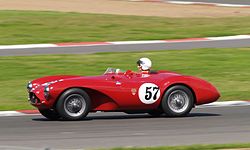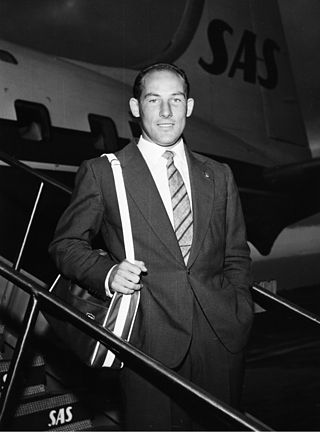
Sir Stirling Craufurd Moss was a British Formula One driver. An inductee into the International Motorsports Hall of Fame, he won 212 of the 529 races he entered across several different motorsports competitions and has been described as "the greatest driver never to win the Formula One World Championship". In a seven-year span between 1955 and 1961 Moss finished in second place four times and in third place three times.

The Aston Martin DB9 is a grand tourer produced by Aston Martin. Available both in coupé and a convertible bodystyles, the latter being known as the Volante, the DB9 was the successor to the DB7. It was first shown at the 2003 Frankfurt Auto Show, and was the first model built at Aston Martin's Gaydon facility.
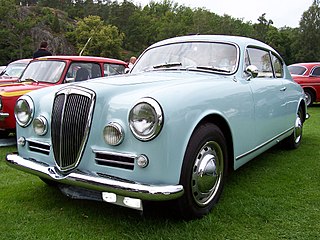
A grand tourer (GT) is a type of car that is designed for high speed and long-distance driving, due to a combination of performance and luxury attributes. The most common format is a front-engine, rear-wheel-drive two-door coupé with either a two-seat or a 2+2 arrangement. Grand tourers are most often the coupé derivative of luxury saloons or sedans.
In the automotive industry, S.H. Arnolt Inc. of Chicago and Warsaw, Indiana, sold four different manufacturer's cars with Bertone bodies during the period 1953 to 1968.

Peter John Collins was a British racing driver. He was killed in the 1958 German Grand Prix, just weeks after winning the RAC British Grand Prix. He started his career as a 17-year-old in 1949, impressing in Formula 3 races, finishing third in the 1951 Autosport National Formula 3 Championship.

Roy Francesco Salvadori was a British racing driver and team manager. He was born in Dovercourt, Essex, to parents of Italian descent. He graduated to Formula One by 1952 and competed regularly until 1962 for a succession of teams including Cooper, Vanwall, BRM, Aston Martin and Connaught. Also a competitor in other formulae, he won the 1959 24 Hours of Le Mans in an Aston Martin with co-driver Carroll Shelby.

Reginald Harold Haslam Parnell Sr. was a racing driver and team manager from Derby, England. He participated in seven Formula One World Championship Grands Prix, achieving one podium, and scoring a total of nine championship points.

The Aston Martin DB3 and later DB3S were sports racing cars built in the 1950s. Although they used some DB2 parts, they were quite different, being designed specially for racing. The original modifications were done by ex-Auto Union engineer, Eberan von Eberhorst, though others handled the later DB3S work.

The Aston Martin DBR9 is a racing car built by Aston Martin Racing, debuting in 2005 and racing actively in international sportscar racing until the end of GT1 category in 2011. The name DBR9 is derived from the original 24 Hours of Le Mans-winning DBR1 car, named for then-owner David Brown, which not only won the 24 Hour race in 1959 but also the World Sportscar title. The car is most famous for taking two LMGT1 class wins at Le Mans 24 Hours by the Aston Martin Racing factory team.
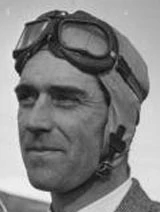
Peter Douglas Conyers Walker was an English racing driver. He was born in Huby, Yorkshire and died in Newtown, Worcestershire. He proved a strong driver in most disciplines, but was most adept in sports cars, winning the 1951 24 Hours of Le Mans race, and the Goodwood Nine-Hours in 1955. He effectively retired after a crash in 1956 left him with serious injuries.
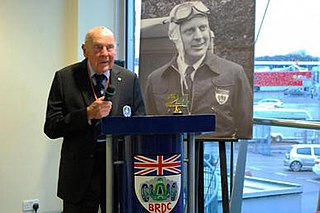
Eric David Thompson was a British racing driver, book dealer and insurance broker. He participated in sports car racing between 1949 and 1955 taking his greatest success by finishing third in the 1951 Les 24 Heures du Mans and took part in the 1952 RAC British Grand Prix.

The Lagonda Straight-6 is a famous automobile engine used by Aston Martin and Lagonda marques in the 1950s. Designed by Willie Watson under the supervision of Walter Owen Bentley of Bentley Motors Limited, it vaulted Aston Martin to fame as a maker of desirable sports and racing cars.
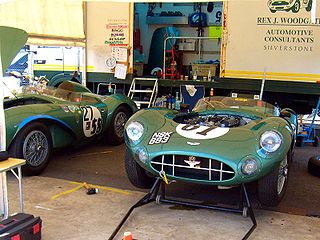
The Aston Martin DBR1 was a sports racing car built by Aston Martin starting in 1956, intended for the World Sportscar Championship as well as non-championship sportscar races at the time. It is most famous as the victor of the 1959 24 Hours of Le Mans, Aston Martin's only outright victory at the endurance classic. It is one of only three cars in the 1950s to win both the World Sports Car Championship and Le Mans 24 Hours in the same year. In addition the six World Sports Car Championship victories was a record for any car in the 1950s and remained a record in the championship until surpassed by the Ferrari 250TR. The three consecutive triumphs in 1959 at the Nürburgring, Le Mans and the Tourist Trophy equalled the record set by the Ferrari 250TR with its three consecutive victories at the start of the 1958 season.

The Aston Martin DBR2 was a sports racing car built in 1957 as a sibling to the Aston Martin DBR1, yet competing in a larger engine capacity group.

The Aston Martin DP212 was a prototype sports car developed by Aston Martin for use in the 1962 24 Hours of Le Mans.

The Aston Martin DP214 was a prototype sports car developed by Aston Martin for use in grand touring-style racing, including the 24 Hours of Le Mans. Two DP214s were built in 1963, with one surviving today.

The Nimrod NRA/C2 was the only Group C racing car ever built by Nimrod Racing Automobiles in partnership with Aston Martin. It ran initially in 1982 in the World Endurance Championship before also joining the IMSA GT Championship. The final NRA/C2 would be retired in 1984 after the planned NRA/C3 replacement had been cancelled and the company went bankrupt.

The Aston Martin DBR4/250, commonly referred to simply as the DBR4, is a Formula One racing car, designed by Ted Cutting for the sports car manufacturer Aston Martin. Following notable successes in sports car racing during the mid- to late-1950s — culminating in winning the 24 Hours of Le Mans endurance race and the World Sportscar Championship title in 1959 — the DBR4 was intended to repeat this success in the highest tier of open-wheel racing.

Aston Martin Racing is a British auto racing team established in 2004 as a partnership between automobile manufacturer Aston Martin and engineering group Prodrive. The partnership was initially created for the purpose of returning Aston Martin to sports car racing with the DBR9, a heavily modified variant of the Aston Martin DB9. Since the DBR9's racing debut in 2005, Aston Martin Racing has expanded to build a variety of cars available to customers, as well as development of Aston Martin's V12 engine for Le Mans Prototype use. Aston Martin Racing's program has earned several successes over the years.
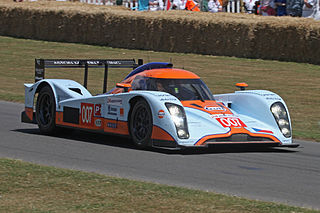
The Lola-Aston Martin B09/60, also known as the Aston Martin DBR1-2, is a Le Mans Prototype sports car built by Lola Cars International and co-developed with Prodrive for use by Aston Martin Racing. It is the first prototype to bear the Aston Martin name since the AMR1 in 1989. Aston Martin's internal name for the car, DBR1-2, refers to the specific DBR1 chassis which won six races in 1959 en route to clinching the World Sportscar Championship as well as that year's 24 Hours of Le Mans.


